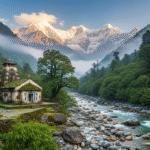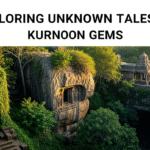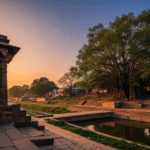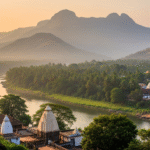Imagine a lost empire’s splendor, hidden by time but still speaking through ruins. In Karnataka, a 14th-century city waits silently, its story told in stone. This was Vijayanagara, now Hampi, spanned from 1336 to the 17th century. As a UNESCO World Heritage site since 1986, Hampi shows off India’s architecture and history.
In Hampi, the Tungabhadra River flows calmly. Boulders lie around like giants placed them there. Each temple and palace tells stories of bravery and faith.
A standout is the Virupaksha Temple, alive with rituals since the 7th century. It’s one of India’s oldest temples. Nearby, the Elephant Stables and ancient stepwells speak of the past.
As daylight fades, Matanga Hill casts golden lights over ruins. This moment offers a special view into the past. A trip to the Archaeological Museum in Hampi takes one through centuries. For visitors planning a trip or seeking tips, Hampi has many treasures.
Key Takeaways
- Hampi is a testament to the splendor of the Vijayanagara Empire, endowed with UNESCO recognition for its historical value.
- The city holds some of the oldest continuously worshiped temples in India, like the age-old Virupaksha Temple.
- Ingenious water management is showcased through Hampi’s extensive system of ancient stepwells.
- Matanga Hill provides breathtaking views, encapsulating the essence of Hampi in a single gaze.
- Visitors can immerse themselves in history at the Archaeological Museum, which houses relics from the Vijayanagara period.
- The site offers an enlightening journey for travelers with the remnants of royal elephants and palaces to explore.
Exploring Hampi’s Majestic Ruins: A Journey Back in Time
Hampi shows the grandeur of the Vijayanagara dynasty. It’s rich with secrets and stories. Tourists and historians love its ancient tales. Here, ancient ruins tell stories of strength, beauty, and skill.
The Glorious Empire of Vijayanagara
Harihara and Bukka founded Vijayanagara in 1336. It was a center for Hindu culture. The empire saw growth in arts and architecture. This was due to strong leaders and a mix of cultures.
The city’s unique buildings show early tech innovations. Hampi’s walls tell ancient stories. People from around the world come to see its history.
The Sacred Enclave: Hampi’s Virupaksha Temple
The Virupaksha Temple is central to Hampi. It dates back to the 7th century. This temple is still a place where people pray. It connects past and present day worship.
Visiting the temple feels peaceful. Its hallways have carvings that tell royal stories.
Archaeological Significance of the Hampi Monuments
Hampi’s ruins teach us about the Vijayanagara Empire’s life and culture. Archaeologists have studied its remains. These ruins help us understand old social and religious ideas.
The stone chariot and Lotus Mahal are more than just buildings. They are signs of a time filled with scientific and cultural growth.
Hampi is important for history, spirituality, and tourism. It offers a look into a past that helped shape our world.
Unveiling the Myths of Hampi’s Bouldered Landscape
Hampi’s landscape is filled with mystery and myths. It is set in Karnataka, India. This place has a rich history linked with the Vijayanagara Empire. It’s filled with boulders that catch everyone’s eye.
People wonder how these big rocks got to Hampi. Scientists say they came from volcanoes and erosion over time. But local stories think gods from Hindu tales placed them here. This makes Hampi’s culture very special.
Hampi’s rocks make great hidden spots for those who find them. They’re peaceful places away from crowded sites. Here, you can think about the magical stories of the boulders.
For adventurers, these myths add to Hampi’s magic. Stories talk about secret treasures and lost temples. They blend real history with fun tales. It draws people who want to know more about this UNESCO site.
Talking to the locals is great for learning myths. They’ve passed down stories for many years. Their tales make the rocks and places feel alive with myth and history.
Anyone interested in myths, geology, or simply amazing sights will love Hampi. Its landscape takes you on a trip through time and imagination. Each visit feels special and different.
Secrets of Hampi: Mysteries Carved in Stone
Hampi is captivating not just because of its ruins. It’s also because of the stories each rock and building tells. These places are like paintings telling us about a grand past. They mix real history with legends.
Mythological Insights from Hampi’s Iconography
When you explore Hampi, you’ll see amazing carvings at the Virupaksha Temple. These aren’t just for show. They tell ancient stories from Hindu texts. They show us how people in the Vijayanagara Empire lived their faith.
The epics of the Ramayana and the Mahabharata come to life here. Hampi is key to understanding old Hindu symbols. It shows how religion was part of everyday life back then.
The Tale of the City’s Strategic Location
Hampi sat by the Tungabhadra River. This spot was great for defense and farming. It made Hampi a busy and important place in its empire. The river helped in many ways, like defense, farming, and trade.
It even helped with the empire’s water systems, like the big stepwells.
Looking at artifacts and old texts tells us a lot about Hampi. We learn not only what happened and how but also why it mattered. Hampi’s history calls out to those who love history and spirituality. It’s all set in stone for us to find.
Hampi Off the Beaten Path: Discovering Hidden Gems
Many hidden corners in Hampi are waiting to be explored. They are full of secluded vistas and untouched artifacts. For those eager to see these places, Hampi offers unique and deeply personal experiences. Connecting with the land’s history becomes a real journey at Hampi’s hidden spots.
Exploring hidden gems means finding lesser-known historic sites. These places are peaceful, allowing for a close connection with history. In these quiet areas, you can see ancient structures and relics. They offer a moment of peace away from busy tourist spots.
Hampi travel tips say the best times to explore are early mornings or late afternoons. The light during these times makes the ruins look magical. Traveling when it’s not peak season also means fewer people. This is better for the environment, too.
- Bring a good guidebook or maybe hire a local guide who knows Hampi’s less visited places.
- Respect the natural and archaeological sites, remembering that Hampi’s unseen details are as beautiful as its grand views.
- Have the right hiking gear and water, as some hidden spots require walking through rocky areas.
Going off the beaten path in Hampi refreshes the soul. It also makes you appreciate the history and nature there even more. Hampi’s hidden gems are there for those willing to look. These journeys add to the richness of Hampi’s heritage. Every visit becomes a discovery of the past and a personal insight.
Architectural Marvels: A Study of Hampi’s Unique Structures
The breathtaking site of Hampi is known worldwide. It is a UNESCO World Heritage Site. This place shows the skillful engineering of the Vijayanagara Empire. The amazing buildings of Hampi are not just pretty. They also show the smart building methods of that time.
One famous building is the Lotus Mahal Hampi. It is a beautiful mix of Hindu and Islamic design. The palace looks like a lotus flower. It has archways that look like petals. This shows the rich art and architecture of the Vijayanagara period.
Engineering Wonders of the Vijayanagara Era
The Vijayanagara era was known for its smart engineering. Hampi had great water systems for irrigation and management. This shows they were good at planning cities and cared about the environment. Also, Hampi has many big sculptures. These show their skill in making detailed stonework.
Significance of the Lotus Mahal’s Design
The Lotus Mahal is more than just pretty. It shows how different cultures came together back then. It has a design that combines Hindu and Islamic styles. This blend shows a meeting of different cultures. The Lotus Mahal is very important for learning about different building styles and techniques.
Exploring Hampi’s buildings can be even more fun with coracle rides. These boat rides show a special view of Hampi. They add an exciting look at the history of the place. Learn more about these boats and what they mean here.
The wonderful buildings of Hampi remind us of the smart and creative people of the Vijayanagara Empire. They invite people from everywhere to learn about this rich history. Everyone is encouraged to see Hampi’s lasting beauty.
Hampi through the Ages: The Saga of its Rise and Fall
The Vijayanagara dynasty, started in 1336. It shaped southern India’s culture and economy. Hampi, at its core, turned into a bustling city filled with temples and markets.
Hampi was the heart of this empire. It was a cultural center with trade routes to Southeast Asia. The city’s story is one of triumph, architectural beauty, and wealth.
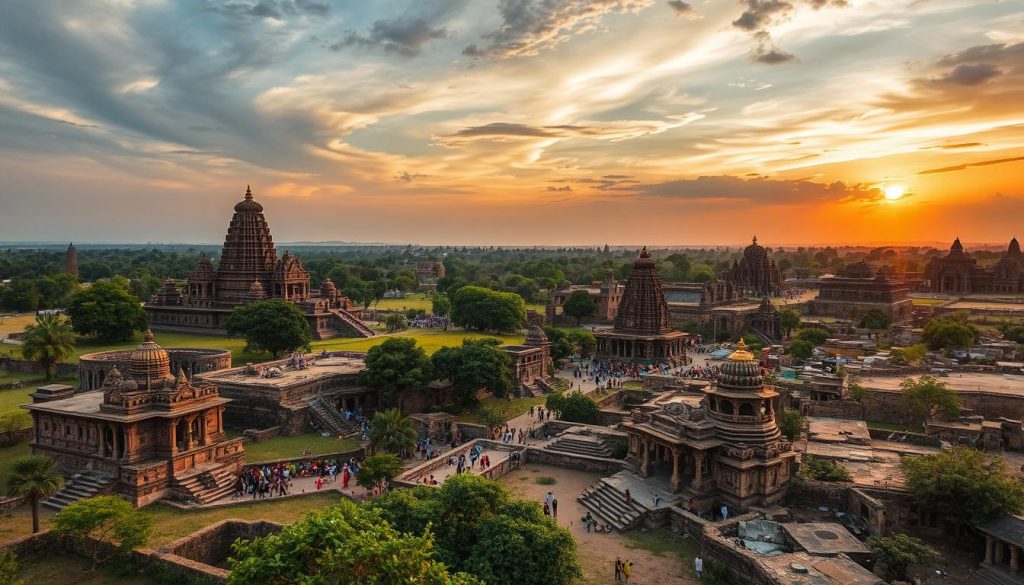
Different dynasties followed the Sangama family. They all added to the region’s culture and religion. The city had many temples showing off its religious diversity and architectural skills. The rulers promoted Hindu traditions and a rich arts scene.
The Battle of Talikota in 1565 was a turning point for Hampi. This battle started its decline and abandonment. What once was a lively and majestic city became ruins.
| Event | Year | Impact on Hampi |
|---|---|---|
| Foundation of Vijayanagara Empire | 1336 | Beginning of Hampi’s rise as a cultural and economic hub |
| Battle of Mudgal | 1366 | Consolidated the power of Vijayanagara dynasty |
| Battle of Talikota | 1565 | Marked the commencement of Hampi’s decline |
| Empire’s lifespan | 1336 – post 1565 | Showcased over a century of resilience and growth |
Hampi’s story is both inspiring and sad. From its peak to its ruins, it shows how great human achievements can be fleeting. People visit Hampi to learn about its glory days and quiet end.
The Intricate Artistry of Hampi’s Ancient Temples
The ancient temples of Hampi show Cultural fusion in architecture. These temples reflect the Vijayanagara Empire’s famous skill. From the grand Virupaksha Temple to the detailed Vijaya Vittala Temple, each building shows unmatched creative skill.
Hampi’s temple artistry is shown in these temples. They also reflect the cultural mix from years of trade and conquest. This mix created a unique style of art. It blends Dravidian and Islamic styles, showing a cultural connection ahead of its time.
The Fusion of Cultures Evident in Temple Architecture
Hampi’s temples tell stories of empire interactions and respect for different arts. Stone carvings show a mix of faiths and regions. They show a rich blend of ideas, reflecting a wide range of historical talks.
Preservation Efforts and Challenges for Hampi’s Artifacts
These temples are facing many threats. Preservation of Hampi is challenging due to natural wear, tourism, and the weather. People are finding new ways to solve these issues. Yet, protecting this heritage is still hard.
Groups are working hard to keep this site safe. They want to keep Hampi’s temple art safe for the future. It is important for visitors to help by respecting these old temples.
To learn more about Hampi’s history, consider exploring the ancient ruins on your next trip. You will see firsthand how special it is.
Hampi Travel Tips: Making the Most of Your Visit
Visiting Hampi is like stepping into a story from long ago. It’s full of history. Travel planning for Hampi means knowing about its big area and many cool things to see. Here are key tips to help you fully enjoy Hampi.
Go to Hampi from November to February. It’s cooler then. This time makes exploring easy and comfy. You won’t have to deal with the big sun.
- Select the right accommodation: Hampi has all kinds of places to stay. Being near the ruins is handy.
- Engage a local guide: A local guide can make Hampi’s history come alive. They share stories you can’t find on your own.
- Plan your transport: Hampi is large, and walking everywhere is hard. Bikes or electric bikes let you see more and have fun.
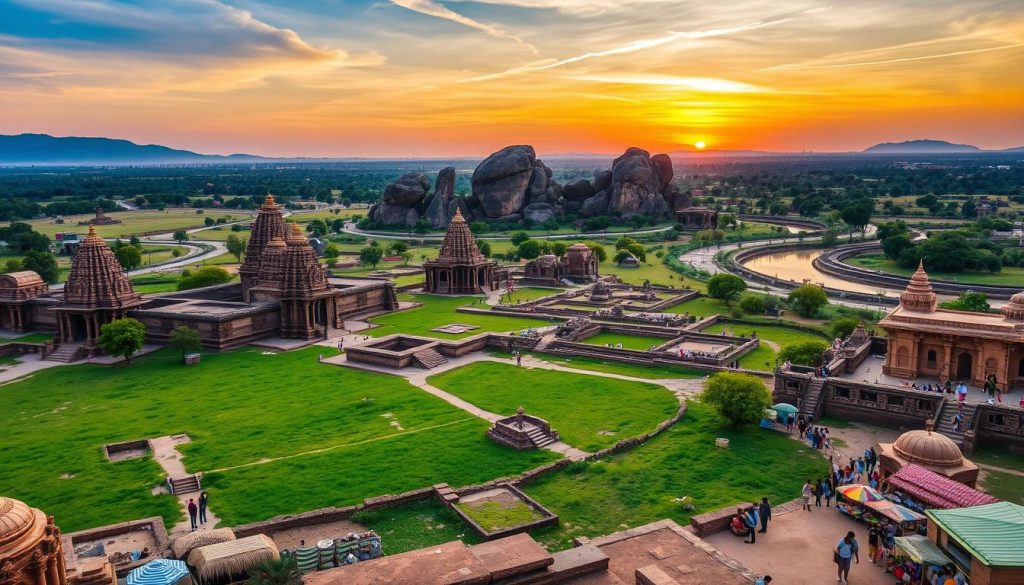
Being respectful in Hampi is important. It’s not just old ruins; it’s a special place for many. Wear modest clothes, be nice, and honor the local customs at temples.
Staying hydrated is key. Always take water with you. Good shoes are a must too. You’ll walk a lot on different paths.
With these tips for exploring Hampi, your trip will be great. It’s a wonderful place for anyone interested in history, spirituality, or just cool places. Hampi is like a journey back in time.
Best Places to Visit in Hampi: A Curated Experience
Hampi sits at the heart of India’s history. It blends spirituality with stunning views. Places like the Monolithic sculptures and Matanga Hill’s views stand out. They are rich in culture and beauty.
Embracing Spirituality at the Monolithic Bull and Narasimha Statues
Hampi’s grand sculptures show its rich past. The Bull and Narasimha statues are not just stone. They reflect the Vijayanagara Empire’s art peak. These statues are a spiritual heart for many. They connect us deeply to Hampi’s glorious history.
The Breathtaking Panoramic Views from Matanga Hill
From Matanga Hill’s top, Hampi looks inspiring. Matanga Hill is the tallest point. It offers beautiful sunrise and sunset views. It’s perfect for soaking in Hampi’s peaceful vibe.
Let’s compare the temples of Hampi’s sacred lands:
| Temple Name | Deity | Visitor Highlights | Opening Hours |
|---|---|---|---|
| Virupaksha Temple | Lord Shiva | Architectural grandeur, Nearby Hampi Bazaar | 6:00 AM to 6:00 PM |
| Vittala Temple | Lord Vishnu | Famous for its Stone Chariot and Musical Pillars | 8:30 AM to 5:30 PM |
| Achyutaraya Temple | Lord Tiruvengalanatha | Exquisite carvings, Less crowded | 6:00 AM to 6:00 PM |
| Krishna Temple | Lord Krishna | Monolithic idols and mythological carvings | 9:00 AM to 5:30 PM |
Hampi combines myths, architecture, and nature. It’s a must-see place. The ancient sculptures and views touch the soul. Visiting Hampi is an unforgettable journey.
Conclusion
Our trip to Hampi has shown us it’s more than just old ruins. It’s a true show of what people can do. Hampi takes us on a journey through time. It lets travelers Unearth Hampi’s secrets. We see its beauty that has lasted through many storms and wars. Every stone here tells a story, keeping the history of the grand Vijayanagara Empire alive and interesting.
The Hampi travel experience is more than just looking at things. It lets us dive deep into India’s history. We see amazing buildings and places where big festivals happened. There are beautiful carvings and big elephant parades that remind us of Mysore’s Jamboo Savari. Hampi makes people see how special it is to India’s history.
Hampi’s old grounds are still filled with life and stories. They invite travelers to explore and feel its timeless beauty. For those who walk here, the place leaves a lasting mark. It encourages them to tell others about the wonders of a place from the past.
FAQ
What are the best historical sites to visit in Hampi?
The best places in Hampi include the Virupaksha Temple, Vitthala Temple, and the Royal Enclosure ruins. You should also see the Monolithic Bull and Narasimha statues and the Archaeological Museum. These spots offer a full view of Hampi’s history.
Are there any travel tips for first-time visitors to Hampi?
Travelers should visit from November to February. It’s cooler then. Drinking lots of water and wearing comfy clothes is wise. Hiring a local guide is a good idea too.
You need enough time to see everything since Hampi is big.
Can you reveal some of the secrets of Hampi?
Hampi has hidden spots like secret chambers and undiscovered artifacts. There are also mythical stories in its art and sculptures. Exploring off the main paths can show Hampi’s magic away from crowds.
What insights can be gained about Vijayanagara dynasty’s history in Hampi?
The ruins in Hampi show how great the Vijayanagara dynasty was. You can learn about their military, religion, and culture. The story of King Krishna Deva Raya and the empire’s fall in 1565 is everywhere.
What is significant about Hampi’s boulder-strewn terrain?
Hampi’s terrain is full of big rocks. This adds to the ancient city’s mystery. It makes the history seem even more magical.
What are some of the architectural marvels in Hampi?
Hampi’s Lotus Mahal is beautiful. It shows Hindu and Islamic styles. There are also smart water systems and big sculptures. The designs and buildings from the past are amazing.
What makes Vijayanagara Empire’s history so compelling?
The Vijayanagara Empire’s story is full of ups and downs. It reached great heights and then fell hard. Each building tells part of this story.
How do Hampi’s ancient temples reflect cultural fusion?
Hampi’s temples mix different building styles and decorations. They show how the empire met many cultures. The carvings show a mix from various places and times.
What efforts are being made for the preservation of artifacts in Hampi?
To save Hampi’s history, there are restoration projects and controlled digs. Protecting the ruins from damage is critical. This keeps Hampi’s art and architecture true to its past.
What are some recommendations for off the beaten path exploration in Hampi?
For quieter spots, check out Anegundi village’s outskirts. Climb Anjaneya Hill. Visit Pampa Sarovar. Find temples and ruins beyond the common paths for a unique Hampi experience.
What are the best practices for visiting Hampi?
Visitors should respect the local culture and religious places. Don’t touch or climb on ancient sites. Help save Hampi by following the Archaeological Survey of India’s rules.
Can visitors enjoy panoramic views in Hampi?
For great views, go to Matanga Hill. The sunrise and sunset views are wonderful. You can see the whole city and the beautiful rocky land around it.


